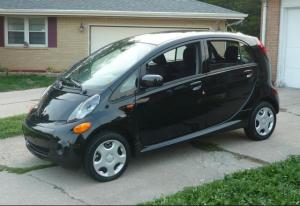| Owner | Brian Konopa | ||||||||
|---|---|---|---|---|---|---|---|---|---|
| Location | Rockford, Illinois United States map | ||||||||
| Web | WebPage | ||||||||
| Vehicle | 2012 Mitsubishi i MiEV | ||||||||
| Motor | 49KW AC Synchronous Motor | ||||||||
| Drivetrain | Single permanent magnet synchronous motor mounted on the rear axle. The vehicle uses a single-speed reduction gear transmission. | ||||||||
| Batteries | 22, 16.00 Volt, Lithium-Ion The 16-kilowatt-hour (58 MJ) lithium-ion battery pack that consists of 88 cells is placed under the base floor. The pack has 22 cell modules connected in series at the nominal voltage of 330 V. There are two 4-cell modules placed vertically at the center of the pack and ten 8-cell modules placed horizontally. It is developed by Mitsubishi and GS Yuasa for both high specific energy and high rate discharge and manufactured by Lithium Energy Japan, a joint venture of GS Yuasa Corporation, Mitsubishi Corporation and Mitsubishi Motors Corporation. The entire pack has a specific energy of 80 Wh/kg. | ||||||||
| System Voltage | 330 Volts | ||||||||
| Charger | Visit recargo.com or any of the other sites that list the national network of charging stations located around the country. Most have free electricity for recharging. | ||||||||
| Top Speed | 81 MPH (130 KPH) Top speed is electronically limited. | ||||||||
| Acceleration | It's worth noting that the i-MiEV has no problem keeping with traffic accerating from a traffic light. It can pull away from the group of average drivers. The only thing that holds it back is liberal use of the accelerator. | ||||||||
| Range | 62 Miles (99 Kilometers) Stated range is from the US EPA cycle. Longer range is possible with lower use of AC and different driving conditions than the test conditions. The vehicle is able to display the estimated remaining range. My actual range is closer to 72 miles on a full charge. | ||||||||
| Watt Hours/Mile | My driving yields an average above 4 miles per kilowatt hour when driving without the defroster in winter or A/C in summer. | ||||||||
| EV Miles |
| ||||||||
| Seating Capacity | 4 adults. The two rear seats fold forward to provide additional cargo space when required. It's not cavernous, but it maximizes carrying potential. | ||||||||
| Curb Weight | 2,400 Pounds (1,090 Kilograms) | ||||||||
| Conversion Cost | MSRP: $30,675.00 with $2,000 off sticker price. Vehicle is base model ES with only optional equipment being the DC Quick Charge Port. Vehicle is eligible for $7,500 US federal tax credit (money will be realized when filing taxes) and $3,067.50 Illinois state rebate (checks issued by state twice a year). Also received 0% for 48 months financing. | ||||||||
| Additional Features | License Plates: State of Illinois issues two-year plates for electric vehicles (EL). The cost is $35 for renewal plates. The cost is prorated at the time of initial vehicle purchase depending on how much of the two-year period is remaining. | ||||||||
| Charging Times: Using household 110V (Level 1) to recharge fully drained battery is about 22 hours. Using 220V charger (Level 2) would take about 6 hours. Using the DC Quick Charge Port (Level 3) would take 30 minutes for an 80% recharge. The local rate for electricity is $0.0911 per kW/hr.) (The rate has since been reduced to $0.0684 per kW/hr.) If the first overnight charging is representative of future charging, then it will cost about $0.025 (2.5 cents) per mile. New rate is closer to 2 cents per mile. A KILL A WATT Power Meter was being used to record the actual kilowatts used for each charging session. At one point, a total of $79.02 had been spent to recharge car. (1133.25 kWhours) That is under $6 per month for my daily driver! | |||||||||
Copyright © 1997-2025 by Mike Chancey







